Papua New Guinea May 2006

Papua New Guinea, also known as PNG, is a group of Islands between Indonesia and the Solomons, just to the north of Australia. Weíve heard so many good things about the diving in PNG that we decided to go there instead of the Solomons for a change. We joined Cathy Church on one of her trips on the Stardancer, and added a second trip immediately after to make the most of it. Like many of the better dive destinations, itís a bit of a hassle to get to. You fly to Brisbane, Australia, and from there take a 2-3 hour flight to Port Moresby, where you board an island hopper and fly to Hoskins, a small regional airport on New Britain island near Kimbe Bay.
We arrived a day before boarding the Stardancer. Itís not absolutely necessary to do that, but itís recommended since itís not unheard of for your luggage to arrive a bit later. Right where you board the Stardancer there is a well known resort named Walindi Plantation which is a great place to spend that one night. I can even recommend flying in a few days earlier and spend a few days there just exploring the fascinating insect life around the resort. We saw giant butterflies, giant spiders, giant walking sticks, and all kinds of other creepy crawlies. You can also dive from the resort, but since we were planning enough diving already, we skipped that.
 The Stardancer is a pretty ship to look at. Itís a converted oilrig ferry ship, and now has 8 cabins for a total of 16 guests. Our cabin was spacious enough, but there is no room for your luggage. Itís best to just empty your suitcases and give them to the crew who will put them somewhere else on the ship. One thing that immediately struck me was that the Stardancer is not well equipped for a large group of photographers. The battery charging area is tiny, but with some juggling our group of 13 photographers could just fit. The large camera housings were a different matter though. There really isnít a good camera setup area. You either set it up on the semi-wet dive deck and just are careful, or take it up a floor and use the 3 small tables there. There also isnít a good spot to put your array of extra lenses, ports, and other equipment that has to stay dry. We kept our stuff in our carry-on, which isnít really water proof, but it was better than nothing. Basically wet and dry camera gear was sharing the same space at the same time.
The Stardancer is a pretty ship to look at. Itís a converted oilrig ferry ship, and now has 8 cabins for a total of 16 guests. Our cabin was spacious enough, but there is no room for your luggage. Itís best to just empty your suitcases and give them to the crew who will put them somewhere else on the ship. One thing that immediately struck me was that the Stardancer is not well equipped for a large group of photographers. The battery charging area is tiny, but with some juggling our group of 13 photographers could just fit. The large camera housings were a different matter though. There really isnít a good camera setup area. You either set it up on the semi-wet dive deck and just are careful, or take it up a floor and use the 3 small tables there. There also isnít a good spot to put your array of extra lenses, ports, and other equipment that has to stay dry. We kept our stuff in our carry-on, which isnít really water proof, but it was better than nothing. Basically wet and dry camera gear was sharing the same space at the same time.
The normal dive schedule is a bit brutal. The first dive is at 06:30, with 2 more dives before lunch at 9 and 11:30. When you ask the crew why they maintain this schedule, they say itís to cram 5 dives into the day and be able to drink wine at dinner. I canít imagine how people manage that and set up their equipment. Cathy asked them to change the schedule to the one that Bilikiki uses, and they agreed. Now our first dive was at 08:00, with subsequent dives at 11:00, 14:00, 17:00 and 20:00. If you donít want to do a night dive (which is a real night dive instead of a crepuscular dive), you can actually get a good nightís rest and head to bed right after dinner around 19:30. On the normal schedule thatís not that easy because the last dive is BEFORE dinner, with dinner finished around 20:00. So even though it seems about the same time, because the first dive is 1,5 hours earlier you donít get as much sleep. But everyone is different, and Iím sure the original schedule will appeal to some people.
The first dive Julie and I never take our camera, but use it to check out our gear, buoyancy etc. The water turned out to be very warm, and our 3mm wetsuits were nice and comfy. After we got ourselves sorted we explored a bit on the dive site, Midway, and found a Denise pygmy seahorse. Not bad for a first dive!
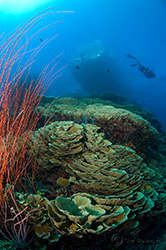 The rest of the first two days we did some sites on the rim of an old caldera in an area called Fathers. The sites were often close to each other and were very similar in nature, mostly bommies with a reef wall along the edge. The ship would often park right on top of the bommie making it quite easy to find your way back. The Stardancer does not do any kind of tender service, so being able to find your way back is recommended. We saw the usual suspects around the bommies; nudibranchs, anemones, schooling fish, turtles, some sharks, crabs, shrimps, etc. Nothing too spectacular, although thatís all relative of course. A lot of the really interesting critters werenít around, maybe because of the very warm water. We did see our first boxer crab on the second day on a site called Killibobís Knob, but theyíre probably all over the place. Anyways, itís early into the trip, so what can you expect. This is PNG, so itís going to rock.
The rest of the first two days we did some sites on the rim of an old caldera in an area called Fathers. The sites were often close to each other and were very similar in nature, mostly bommies with a reef wall along the edge. The ship would often park right on top of the bommie making it quite easy to find your way back. The Stardancer does not do any kind of tender service, so being able to find your way back is recommended. We saw the usual suspects around the bommies; nudibranchs, anemones, schooling fish, turtles, some sharks, crabs, shrimps, etc. Nothing too spectacular, although thatís all relative of course. A lot of the really interesting critters werenít around, maybe because of the very warm water. We did see our first boxer crab on the second day on a site called Killibobís Knob, but theyíre probably all over the place. Anyways, itís early into the trip, so what can you expect. This is PNG, so itís going to rock.
Around this time is when we got our first good look at our captain Alan. Normally Alan runs the Febrina but he was especially requested by Cathy to run this charter on the Stardancer because of his knowledge of the region. Heís quite a character, and his reputation preceded him. We didnít actually see much of him during the trip, except towards the end of the trip when he came asking if anybody had any serious pain medication with them. He said he had a terrible headache, maybe a returning malaria bout. He did do a good job of keeping us out of harm, and on the right reefs at the right time.
The guides on the Stardancer are quite good. We had actually heard of two of them before, Elsie and Josie. They are a bit of a legend in the PNG area and their critter skills turned out to be as exceptional as we were told. On every dive they managed to find small little things. Once they know what you like they try even harder to find it for you. A continuous flood of small critters awaited us. This is not in the least the result of there being 4(!) diveguides in the water at the same time. If you don't see anything, you have only yourself to blame.
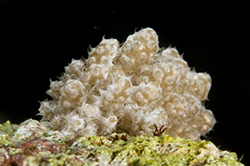 One of the many bommies brought our first white pygmy of the trip. There were actually 3 of these Hippocampus colemani there. While most people were trying their best to see and photograph the pygmies, Julie and I turned our attention to something Elsie pointed out. It turned out to be a very interesting nudibranch that we had never seen before. When we got back to the boat we couldn't find it in any of the books. Only weeks later we found out it was a known, but as of yet, unnamed species. Our spirits were high and full of anticipation.
One of the many bommies brought our first white pygmy of the trip. There were actually 3 of these Hippocampus colemani there. While most people were trying their best to see and photograph the pygmies, Julie and I turned our attention to something Elsie pointed out. It turned out to be a very interesting nudibranch that we had never seen before. When we got back to the boat we couldn't find it in any of the books. Only weeks later we found out it was a known, but as of yet, unnamed species. Our spirits were high and full of anticipation.
 That night we moved to another area called Witu. It's a very pretty area around an old vulcano. Here you get a chance to do a few dives with sharks and barracudas. Especially on a site called Krack-A-Fat we had a lot of action with a large school of barracudas and lots of sharks. They bring out a baitbox for the sharks, and on this occasion it worked nicely.
That night we moved to another area called Witu. It's a very pretty area around an old vulcano. Here you get a chance to do a few dives with sharks and barracudas. Especially on a site called Krack-A-Fat we had a lot of action with a large school of barracudas and lots of sharks. They bring out a baitbox for the sharks, and on this occasion it worked nicely.
At a site called Dickies Place we picked up... Dicky. He lives in this remote area and uses the different liveaboards to travel around. For a few days he camped on the ship and telling us all his PNG stories. Some of the stories about previous vulcano eruptions are quite interesting. As you look around and see several smoking vulcanos you have to wonder when the next eruption will be.
After a few days around Witu we moved again, this time back to Kimbe Bay. A lot of the sites here get frequented by day boats from Walindi, so it's not surprising to find a site already occupied by a day boat. This was something that actually surprised us a bit. This 10 day trip covered a very large area, but every single day we encountered another liveaboard. One night the Paradise Sport parked right next to us and put its flood lights on us all night. I found this quite annoying as the bedrooms have windows and it seem like daylight. If they do it on purpose I don't know, but with all the dives sites around you have to wonder.
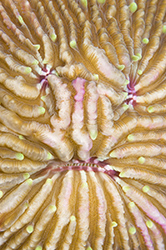 Our favorite dive site in the Kimbe Bay area was Restorf. It's a beautiful little island with resident eagles that come really close to the ship. Underwater it's a sand slope with coral heads and a wall; something for everyone. We found plenty of cool stuff, from little shrimp to squid to crabs, you name it. Amids all this splendor Julie and I had gotten really into doing abstract type photography. Mostly because a lot of the stuff we had already seen many times before, and except for a few hits in the beginning of the trip nothing really special turned up. We both like doing abstracts so we weren't too sad. Sometimes you end up with quite funny ones, like this coral face that Julie found.
Our favorite dive site in the Kimbe Bay area was Restorf. It's a beautiful little island with resident eagles that come really close to the ship. Underwater it's a sand slope with coral heads and a wall; something for everyone. We found plenty of cool stuff, from little shrimp to squid to crabs, you name it. Amids all this splendor Julie and I had gotten really into doing abstract type photography. Mostly because a lot of the stuff we had already seen many times before, and except for a few hits in the beginning of the trip nothing really special turned up. We both like doing abstracts so we weren't too sad. Sometimes you end up with quite funny ones, like this coral face that Julie found.
The last night of the trip is spent at the Walindi dock with a very nice bbq type dinner at the resort. Saying goodbye to all the fellow guests was quite easy as we knew almost all of them from previous trips with Cathy. The goodbyes were more of an until next time.
The next trip wasn't until two days later and we spent those days at Walindi. We just relaxed a bit, did some snorkeling, dolphin watching, and one night we went to see a light bug tree. This is a specific tree, a few minutes drive from Walindi, where hundreds of light bugs come together at night for an amazing spectacle of flashing lights. Whatís especially interesting is that most insects synchronized their flashes, creating a very surreal sight. Imagine a tree at night in the middle of the jungle, with backlight starlight and hundreds of tiny flashes going off every second exactly at the same time, with lots more flashing randomly in between. I had never seen anything like it.
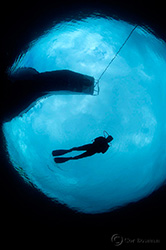 We also spend those two days frantically trying to contact Bilikiki Cruises to book a trip on the Bilikiki directly after the Stardancer trips. While on the Stardancer we decided to add that trip to our itinerary. Unfortunately that was easier said than done. We could not call out to specific countries, and the Ďinternetí link was a very slow 14.4 that dropped offline every few minutes. After two days of agony we managed to get the message across to the Bilikiki. This is definitely not the place to have contact with the outside world.
We also spend those two days frantically trying to contact Bilikiki Cruises to book a trip on the Bilikiki directly after the Stardancer trips. While on the Stardancer we decided to add that trip to our itinerary. Unfortunately that was easier said than done. We could not call out to specific countries, and the Ďinternetí link was a very slow 14.4 that dropped offline every few minutes. After two days of agony we managed to get the message across to the Bilikiki. This is definitely not the place to have contact with the outside world.
Our new captain, Peter, came over from the Pelagian at Wakatobi. Heís not new to the region though, and he seemed like he knew what he was doing. This time we were doing the dive sites in a different order. We started at Witu, at Barneyís. In the shallows on top of the bommie I made an interesting image that looks like a diver swimming in front of the moon. Itís a bit different and I liked it a lot. In the afternoon we did a site we didnít do last trip named Lama Two, and we did the Crator again, a site which is literally inside an extinct vulcano.
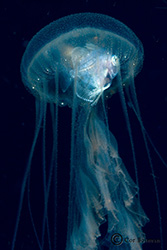 This trip is different than the last one, not just because the captain is different, and some of the crew swapped with the Febrina, but also because this trip wasnít organized. We ended up with a large group of Germans, two French Canadian women, and an American couple. We basically only interacted with the Canadians and the Americans because the German group did not talk to anyone but themselves, while drinking large amounts of alcohol (we ran out of wine on day 2!) and smoking us out of the open air decks. You canít always control who you end up with on a dive trip like this, sometimes it turns out ok, sometimes it doesnít. After a few days some of the Germans warmed up a bit, but all in all very little socializing took place.
This trip is different than the last one, not just because the captain is different, and some of the crew swapped with the Febrina, but also because this trip wasnít organized. We ended up with a large group of Germans, two French Canadian women, and an American couple. We basically only interacted with the Canadians and the Americans because the German group did not talk to anyone but themselves, while drinking large amounts of alcohol (we ran out of wine on day 2!) and smoking us out of the open air decks. You canít always control who you end up with on a dive trip like this, sometimes it turns out ok, sometimes it doesnít. After a few days some of the Germans warmed up a bit, but all in all very little socializing took place.
The next couple of days were very similar to the previous trip. We did Arches, Krack-A-Fat, Dickies Place, and basically every dive we did on the previous trip. At Arches I saw this amazing jellyfish, which had a small juvenile fish hiding inside its body. That was another first for me. We also saw another Hippocampus colemani. Elsie did it again.
We thought it was a fluke at first, but on this second trip we were suddenly confronted with time limited dives. Every first dive was limited to 60 minutes. Itís not a real problem, but kind of strange as they put so much emphasis on this being a no-limit liveaboard. We think Peter had changed the rules. Alan is quite a bit easier, which sortof showed in the state of the ship. Not that it was in any way bad, but some little nuisances were all over. Peter fixed all those quite quickly and interacted with the passengers and crew a lot.
The 4th diving day was one of extremes. First we got to experience some very nasty current. The kind that rips your mask off your face if you turn your head sideways. Several people were having fun with reef hooks, but I had forgotten to put mine in my BCD so I was trying to hide behind anything I could find. Unfortunately it was more like a washing machine than a normal current, so hiding wasnít easy. When I got back on board I was exhausted from the current, lugging my camera around, and trying to do a proper safety stop. Needless to say I didnít take any pictures.
 Then on the other extreme, the next dive changed the whole trip for me from somewhat uneventful to fulfilling. I found my first blue ring octopus, and a big one at that. I called everyone over and got a thumbs up from Elsie. It did the whole show, going over the reef hunting for food, flashing all kinds of colors; it was just spectacular to watch for about 15 minutes. It turned out it was most peopleís first blue ring octopus and everyone was quite happy.
Then on the other extreme, the next dive changed the whole trip for me from somewhat uneventful to fulfilling. I found my first blue ring octopus, and a big one at that. I called everyone over and got a thumbs up from Elsie. It did the whole show, going over the reef hunting for food, flashing all kinds of colors; it was just spectacular to watch for about 15 minutes. It turned out it was most peopleís first blue ring octopus and everyone was quite happy.
 At night we got our final icing on the cake as tens of thousands of bait fish congregated around the boat. Diving amongst them was amazing, with tuna, jacks and silvertip sharks showing up for the feast. A day to remember.
At night we got our final icing on the cake as tens of thousands of bait fish congregated around the boat. Diving amongst them was amazing, with tuna, jacks and silvertip sharks showing up for the feast. A day to remember.
After this things dwindled down again. We saw the usual suspects, but the endless bommie diving was getting a little repetative. They didnít even have to change the dive brief drawings at times. We did a few shark bait dives, but of 4 dives, only 1 really attracted any sharks. Things were just a little monotonous, not at all what I had expected.
Even though the diving in Kimbe is amazing, our high expectations were a little too high. The dive guides told us that this wasnít the right season, and that in other seasons there are more creatures around. We didnít see any ghost pipefish, no frogfish, etc. On the other hand, we did see a blue ring octopus, and some nudibranchs we canít identify. Without overly high expectations the diving here is really good and if you haven't been diving in this area before you'll love it.
The
|

|
End
|